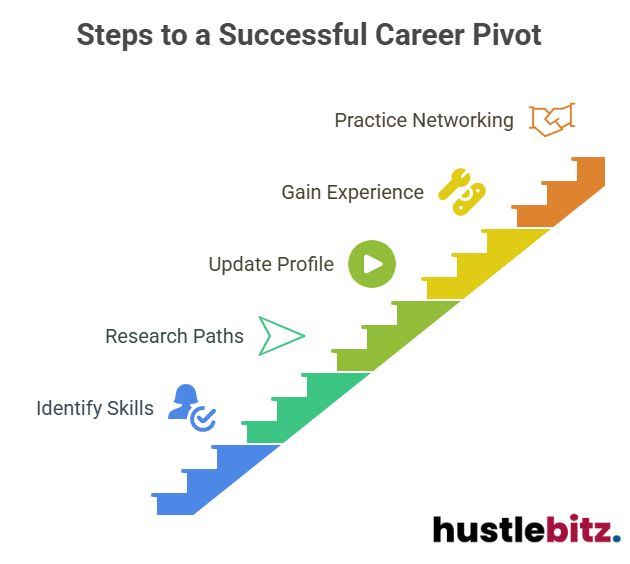Navigating career pivots requires a strategic approach. Start by identifying your transferable skills, which will help bridge gaps between your current and desired roles. Research potential career paths to understand trends and opportunities, and update your resume and profile to reflect your strengths. Gaining relevant experience through volunteering or freelance projects is essential for building your portfolio. Incorporate a structured learning plan to address skill gaps, and practice effective networking strategies to expand your connections. Adopt a growth mindset to embrace challenges. These strategies lay the foundation for a successful transition into a new career and offer more insights for further exploration.
Key Takeaways
- Identify transferable skills through a comprehensive assessment to leverage existing strengths in your career pivot.
- Research potential career paths by exploring industry trends and conducting informational interviews to understand needed skills.
- Update your resume and professional profile to effectively showcase relevant experiences and align with industry language.
- Gain relevant experience through volunteering, freelance projects, or online courses to build your skills and portfolio.
- Practice networking strategies by attending events and engaging with professionals to expand your connections and opportunities.

Identify Transferable Skills
Identifying transferable skills is essential for successfully navigating a career pivot, as it enables professionals to leverage their existing strengths in new and diverse environments. A comprehensive skill assessment is the first step in this process, allowing individuals to catalog their competencies and recognize which skills are applicable across different industries.
This assessment not only highlights technical abilities but also emphasizes soft skills such as communication, problem-solving, and leadership, which are universally valued.
Understanding industry relevance is crucial in showcasing how these transferable skills can meet the demands of a new career. By aligning their strengths with the needs of potential employers, professionals can enhance their personal branding. This strategic positioning communicates the value they bring to prospective roles, thereby increasing their chances of success in a competitive job market.
Moreover, confidence building plays a pivotal role during this transition. As professionals gain clarity on their transferable skills, they are likely to feel more empowered in their decision-making process. Engaging in adaptability training further equips them to navigate the complexities of a new industry, fostering resilience and a growth mindset.
In essence, identifying transferable skills not only facilitates a smoother career pivot but also promotes a sense of freedom and exploration. By leveraging their unique skill set, professionals can confidently embark on new journeys, unlocking opportunities that align with their passions and aspirations.
Research Potential Career Paths

After recognizing and assessing transferable skills, the next step involves thoroughly researching potential career paths that align with those competencies and interests. Engaging in career exploration is essential for understanding the diverse opportunities available in today’s dynamic job market. Begin by identifying industries that excite you and evaluate current industry trends to ensure your choices are relevant and viable.
Job shadowing can provide invaluable insights into daily responsibilities and workplace culture, allowing you to experience a role firsthand. This approach also facilitates the cultivation of professional relationships, which can be instrumental in your transition. Additionally, consider conducting informational interviews with professionals in your desired fields. These conversations can yield information about the nuances of a role, required skills, and potential challenges, thereby enhancing your understanding of various career paths.
Furthermore, a comprehensive skill assessment will aid in identifying gaps between your current capabilities and those needed for your target positions. This awareness will guide your learning and development efforts, ensuring you are well-prepared for a successful transition.
As you delve deeper into potential careers, remain open to exploring unconventional paths that may not have been on your radar initially. The freedom to pivot your career is empowering; by conducting thorough research and utilizing different exploration methods, you can confidently choose a direction that resonates with your aspirations and skills.
Update Your Resume and Profile

An updated resume and professional profile are crucial tools for effectively showcasing your skills and experiences as you navigate a career pivot. The first step in this process is to ensure your resume formatting is clean, professional, and tailored to highlight your most relevant experiences. Utilize clear headings and bullet points to help prospective employers easily digest your information.
Next, focus on incorporating profile keywords that align with the industry you aim to enter. This strategic use of language enables you to connect with hiring managers and applicant tracking systems, making your application more visible. Avoid excessive industry jargon that may alienate those outside your previous field; instead, aim for clarity that reflects your adaptability and willingness to embrace new challenges.
Your achievements showcase is another vital component. Quantify your successes with specific metrics to demonstrate the impact you can bring to a new role. For example, stating that you “increased sales by 30%” paints a vivid picture of your capabilities.
Gain Relevant Experience

Gaining relevant experience is essential for demonstrating your commitment to a new career path and enhancing your skill set. As you navigate your transition, seeking opportunities that align with your desired field not only bolsters your resume but also builds your confidence and network.
Here are three effective methods to gain that vital experience:
- Volunteer Opportunities: Engaging in volunteer work allows you to apply your skills in real-world scenarios while contributing to causes you care about. This experience can provide valuable insights into your new industry and help expand your professional connections.
- Freelance Projects: Taking on freelance projects enables you to work on specific tasks or assignments relevant to your new career. This approach allows you to build a portfolio that showcases your capabilities and adaptability, while also providing flexibility to explore various aspects of your desired field.
- Mentorship Programs and Job Shadowing: Connecting with a mentor in your new industry can provide invaluable guidance and insights. Additionally, job shadowing allows you to observe the day-to-day operations of professionals, helping you understand the nuances of the role and industry.
Moreover, consider enrolling in online courses that offer specialized training to fill any skill gaps. By strategically pursuing these avenues, you can effectively position yourself for success in your new career, creating a pathway to freedom and fulfillment.
Develop a Learning Plan

Creating a structured learning plan is crucial for effectively acquiring the skills and knowledge necessary to thrive in your new career path. A well-defined learning plan empowers you to take control of your transition, ensuring that you focus on the right areas for development.
Begin with goal setting, identifying specific, measurable objectives that align with your desired career outcomes. This clarity helps guide your learning journey.
Next, conduct a skill assessment to pinpoint your current capabilities against the skills required for your new role. Understanding your strengths and weaknesses allows you to tailor your learning resources effectively. Utilize various learning resources, such as online courses, workshops, or books, to fill the gaps in your knowledge. Embrace flexibility in your learning methods, as this freedom can enhance your engagement and retention.
Incorporating feedback mechanisms into your learning plan is essential. Regularly seek feedback from peers, mentors, or professional networks to refine your approach and stay on track. This iterative process helps you adapt and improve continuously.
Additionally, explore mentorship opportunities. Connecting with experienced professionals in your target field can provide invaluable insights and guidance. A mentor can help you navigate challenges and offer advice based on their own experiences.
Practice Networking Strategies

Building a strong network is vital for successfully acquiring new opportunities and insights as you shift into a different career path. Engaging with professionals who have traversed similar journeys can provide invaluable perspectives and support.
To enhance your networking strategies, consider the following approaches:
- Attend Networking Events: Participate in industry-specific gatherings, workshops, and conferences to meet individuals who share your interests. These events serve as platforms to forge connections and gain insights into the latest trends and opportunities within your new field.
- Leverage Online Communities: Join relevant online forums and social media groups where professionals in your desired industry interact. Platforms like LinkedIn offer groups tailored to specific career interests, allowing you to engage in discussions, share resources, and connect with like-minded individuals.
- Conduct Informational Interviews: Reach out to alumni connections or professionals you admire and request informational interviews. This approach not only helps you gather first-hand information about their career paths but also opens doors to potential mentorship opportunities. A simple conversation can yield insights that may guide your own transition.
Embrace a Growth Mindset
Embracing a growth mindset is essential for navigating career pivots, as it fosters resilience and adaptability in the face of new challenges and opportunities. A growth mindset encourages individuals to view setbacks as growth opportunities rather than insurmountable obstacles. This perspective allows for significant mindset shifts that can lead to innovative solutions and a refreshed approach to problem-solving.
Incorporating self-reflection techniques into your career transition can enhance your resilience building. By assessing your strengths, weaknesses, and past experiences, you can identify areas for growth and develop strategies to overcome challenges. Below is a table that summarizes key aspects of cultivating a growth mindset during career pivots:
| Aspect | Description |
| Growth Opportunities | Seek new roles or responsibilities that challenge you. |
| Mindset Shifts | Replace negative thoughts with positive beliefs. |
| Resilience Building | Embrace failure as a stepping stone to success. |
| Self Reflection Techniques | Regularly evaluate your progress and adjust your goals. |
| Overcoming Challenges | Develop problem-solving strategies and seek support. |
Final Thoughts
Navigating a career pivot can be a rewarding journey when approached with the right strategies. By identifying your transferable skills, gaining relevant experience, and building a strong network, you can transition smoothly into a new field. Developing a learning plan to address skill gaps and embracing a growth mindset are also crucial for long-term success. Each of these steps allows you to take control of your career path with confidence. Remember, career transitions are opportunities for growth, and with thoughtful planning and perseverance, you can successfully shift into a fulfilling new role.




